Page 370 of 521
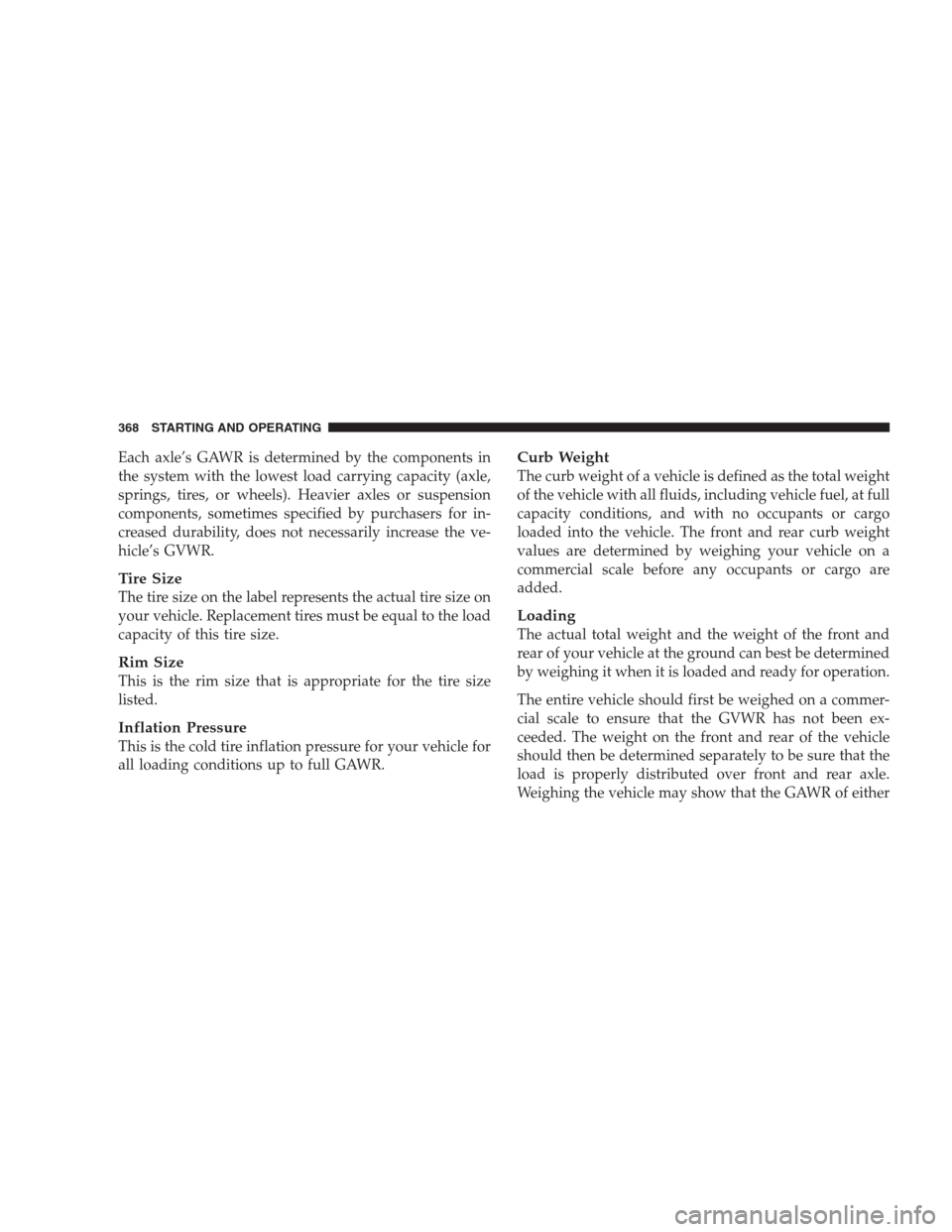
Each axle’s GAWR is determined by the components in
the system with the lowest load carrying capacity (axle,
springs, tires, or wheels). Heavier axles or suspension
components, sometimes specified by purchasers for in-
creased durability, does not necessarily increase the ve-
hicle’s GVWR.
Tire Size
The tire size on the label represents the actual tire size on
your vehicle. Replacement tires must be equal to the load
capacity of this tire size.
Rim Size
This is the rim size that is appropriate for the tire size
listed.
Inflation Pressure
This is the cold tire inflation pressure for your vehicle for
all loading conditions up to full GAWR.
Curb Weight
The curb weight of a vehicle is defined as the total weight
of the vehicle with all fluids, including vehicle fuel, at full
capacity conditions, and with no occupants or cargo
loaded into the vehicle. The front and rear curb weight
values are determined by weighing your vehicle on a
commercial scale before any occupants or cargo are
added.
Loading
The actual total weight and the weight of the front and
rear of your vehicle at the ground can best be determined
by weighing it when it is loaded and ready for operation.
The entire vehicle should first be weighed on a commer-
cial scale to ensure that the GVWR has not been ex-
ceeded. The weight on the front and rear of the vehicle
should then be determined separately to be sure that the
load is properly distributed over front and rear axle.
Weighing the vehicle may show that the GAWR of either
368 STARTING AND OPERATING
Page 372 of 521

Gross Trailer Weight (GTW)
The GTW is the weight of the trailer plus the weight of all
cargo, consumables and equipment (permanent or tem-
porary) loaded in or on the trailer in its�loaded and
ready for operation�condition. The recommended way to
measure GTW is to put your fully loaded trailer on a
vehicle scale. The entire weight of the trailer must be
supported by the scale.
Gross Combination Weight Rating (GCWR)
The GCWR is the total permissible weight of your vehicle
and trailer when weighed in combination. (Note that
GCWR ratings include a 150 lbs (68 kg) allowance for the
presence of a driver).
Gross Axle Weight Rating (GAWR)
The GAWR is the maximum capacity of the front and rear
axles. Distribute the load over the front and rear axles
evenly. Make sure that you do not exceed either front or
rear GAWR.
WARNING!
It is important that you do not exceed the maximum
front or rear GAWR. A dangerous driving condition
can result if either rating is exceeded. You could lose
control of the vehicle and have an accident.
Trailer Tongue Weight (TW)
The TW is the downward force exerted on the hitch ball
by the trailer. In most cases it should not be less than 10%
or more than 15% of the trailer load. You must consider
this as part of the load on your vehicle.
Frontal Area
The frontal area is the maximum height and maximum
width of the front of a trailer.
Weight-Carrying Hitch
A weight-carrying hitch supports the trailer tongue
weight, just as if it were luggage located at a hitch ball or
370 STARTING AND OPERATING
Page 380 of 521
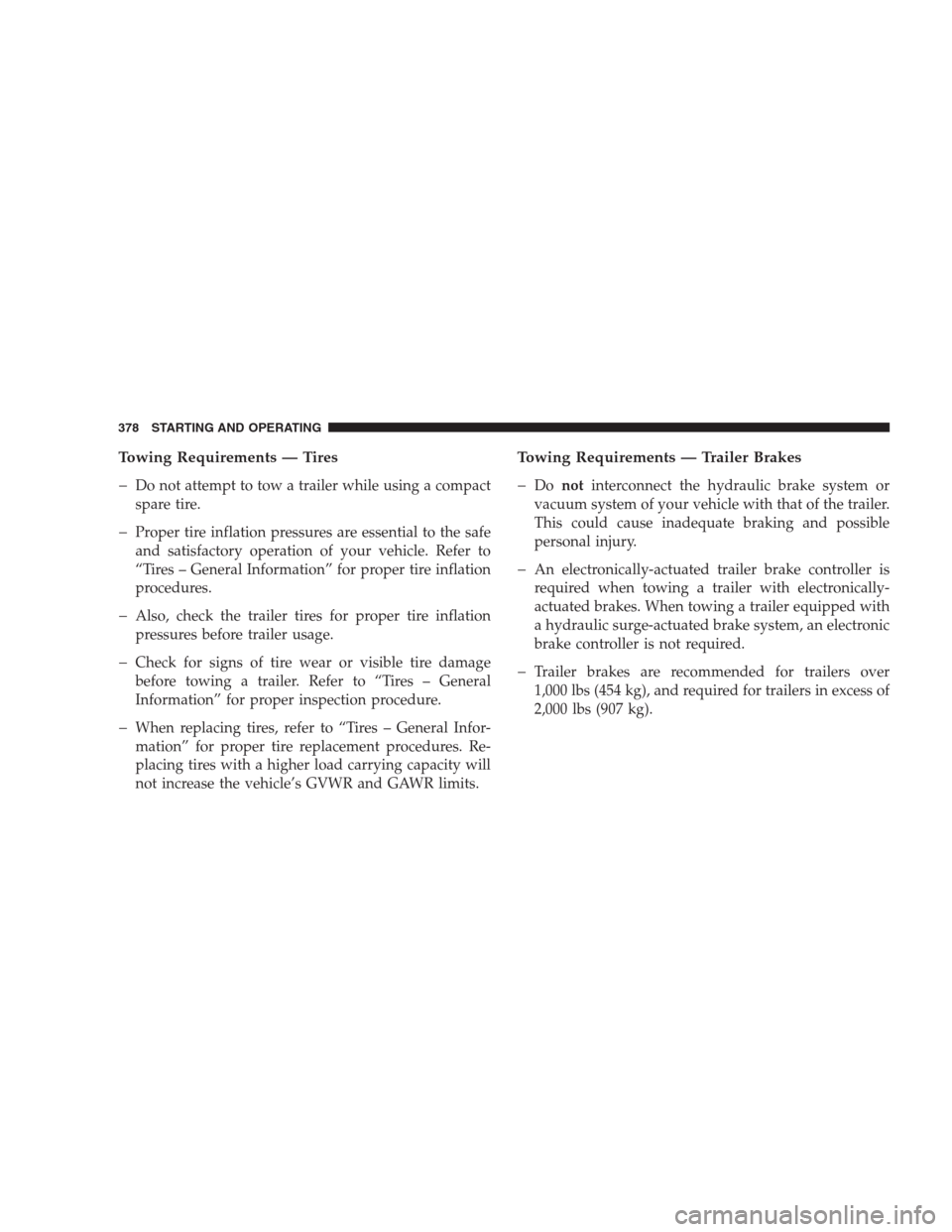
Towing Requirements — Tires
�
Do not attempt to tow a trailer while using a compact
spare tire.
�Proper tire inflation pressures are essential to the safe
and satisfactory operation of your vehicle. Refer to
“Tires – General Information” for proper tire inflation
procedures.
�Also, check the trailer tires for proper tire inflation
pressures before trailer usage.
�Check for signs of tire wear or visible tire damage
before towing a trailer. Refer to “Tires – General
Information” for proper inspection procedure.
�When replacing tires, refer to “Tires – General Infor-
mation” for proper tire replacement procedures. Re-
placing tires with a higher load carrying capacity will
not increase the vehicle’s GVWR and GAWR limits.
Towing Requirements — Trailer Brakes
�
Donotinterconnect the hydraulic brake system or
vacuum system of your vehicle with that of the trailer.
This could cause inadequate braking and possible
personal injury.
�An electronically-actuated trailer brake controller is
required when towing a trailer with electronically-
actuated brakes. When towing a trailer equipped with
a hydraulic surge-actuated brake system, an electronic
brake controller is not required.
�Trailer brakes are recommended for trailers over
1,000 lbs (454 kg), and required for trailers in excess of
2,000 lbs (907 kg).
378 STARTING AND OPERATING
Page 381 of 521
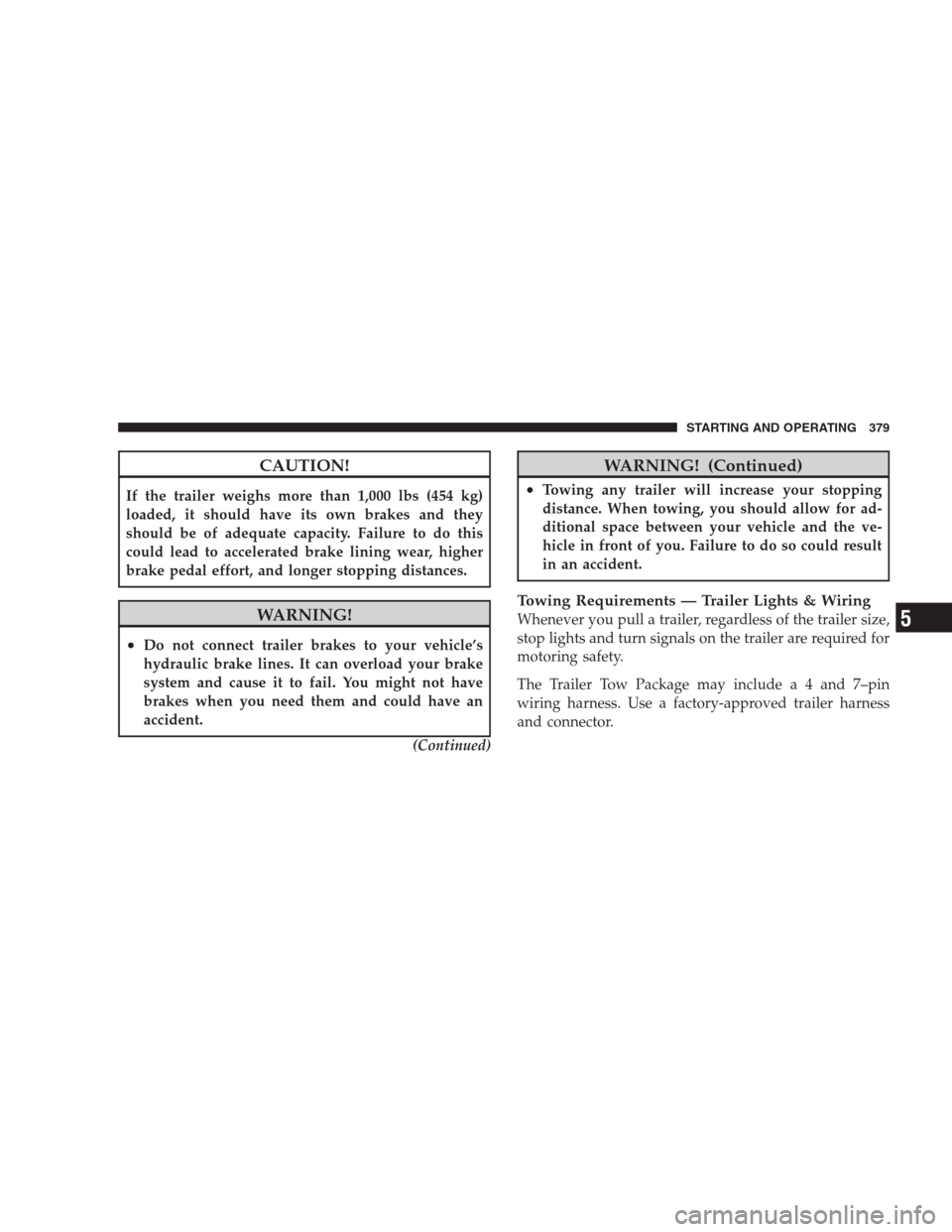
CAUTION!
If the trailer weighs more than 1,000 lbs (454 kg)
loaded, it should have its own brakes and they
should be of adequate capacity. Failure to do this
could lead to accelerated brake lining wear, higher
brake pedal effort, and longer stopping distances.
WARNING!
•Do not connect trailer brakes to your vehicle’s
hydraulic brake lines. It can overload your brake
system and cause it to fail. You might not have
brakes when you need them and could have an
accident.
(Continued)
WARNING! (Continued)
•Towing any trailer will increase your stopping
distance. When towing, you should allow for ad-
ditional space between your vehicle and the ve-
hicle in front of you. Failure to do so could result
in an accident.
Towing Requirements — Trailer Lights & Wiring
Whenever you pull a trailer, regardless of the trailer size,
stop lights and turn signals on the trailer are required for
motoring safety.
The Trailer Tow Package may include a 4 and 7–pin
wiring harness. Use a factory-approved trailer harness
and connector.
STARTING AND OPERATING 379
5
Page 502 of 521
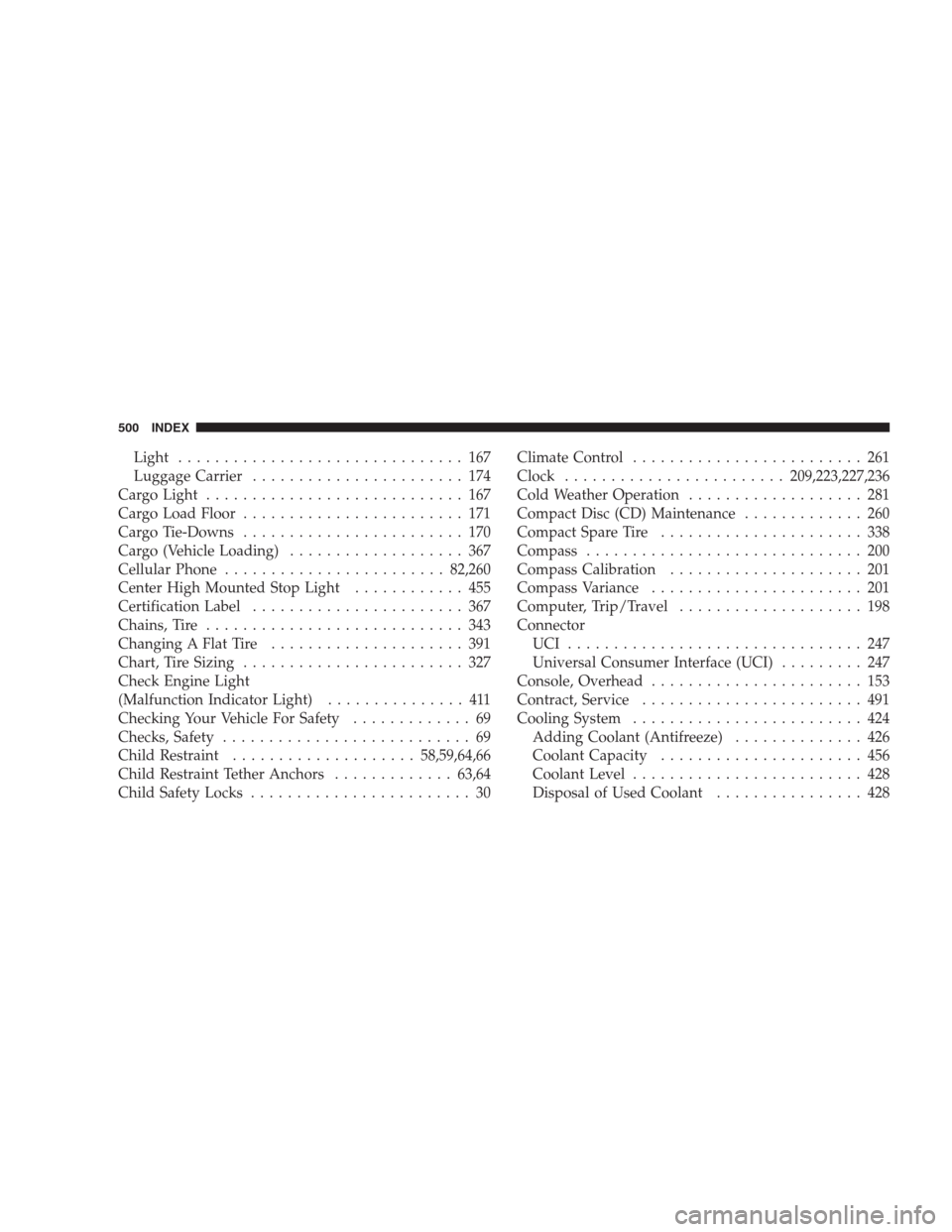
Light............................... 167
Luggage Carrier....................... 174
Cargo Light............................ 167
Cargo Load Floor........................ 171
Cargo Tie-Downs........................ 170
Cargo (Vehicle Loading)................... 367
Cellular Phone........................82,260
Center High Mounted Stop Light............ 455
Certification Label....................... 367
Chains, Tire............................ 343
Changing A Flat Tire..................... 391
Chart, Tire Sizing........................ 327
Check Engine Light
(Malfunction Indicator Light)............... 411
Checking Your Vehicle For Safety............. 69
Checks, Safety........................... 69
Child Restraint....................58,59,64,66
Child Restraint Tether Anchors.............63,64
Child Safety Locks........................ 30Climate Control......................... 261
Clock........................209,223,227,236
Cold Weather Operation................... 281
Compact Disc (CD) Maintenance............. 260
Compact Spare Tire...................... 338
Compass.............................. 200
Compass Calibration..................... 201
Compass Variance....................... 201
Computer, Trip/Travel.................... 198
Connector
UCI ................................ 247
Universal Consumer Interface (UCI)......... 247
Console, Overhead....................... 153
Contract, Service........................ 491
Cooling System......................... 424
Adding Coolant (Antifreeze).............. 426
Coolant Capacity...................... 456
Coolant Level......................... 428
Disposal of Used Coolant................ 428
500 INDEX
Page 516 of 521
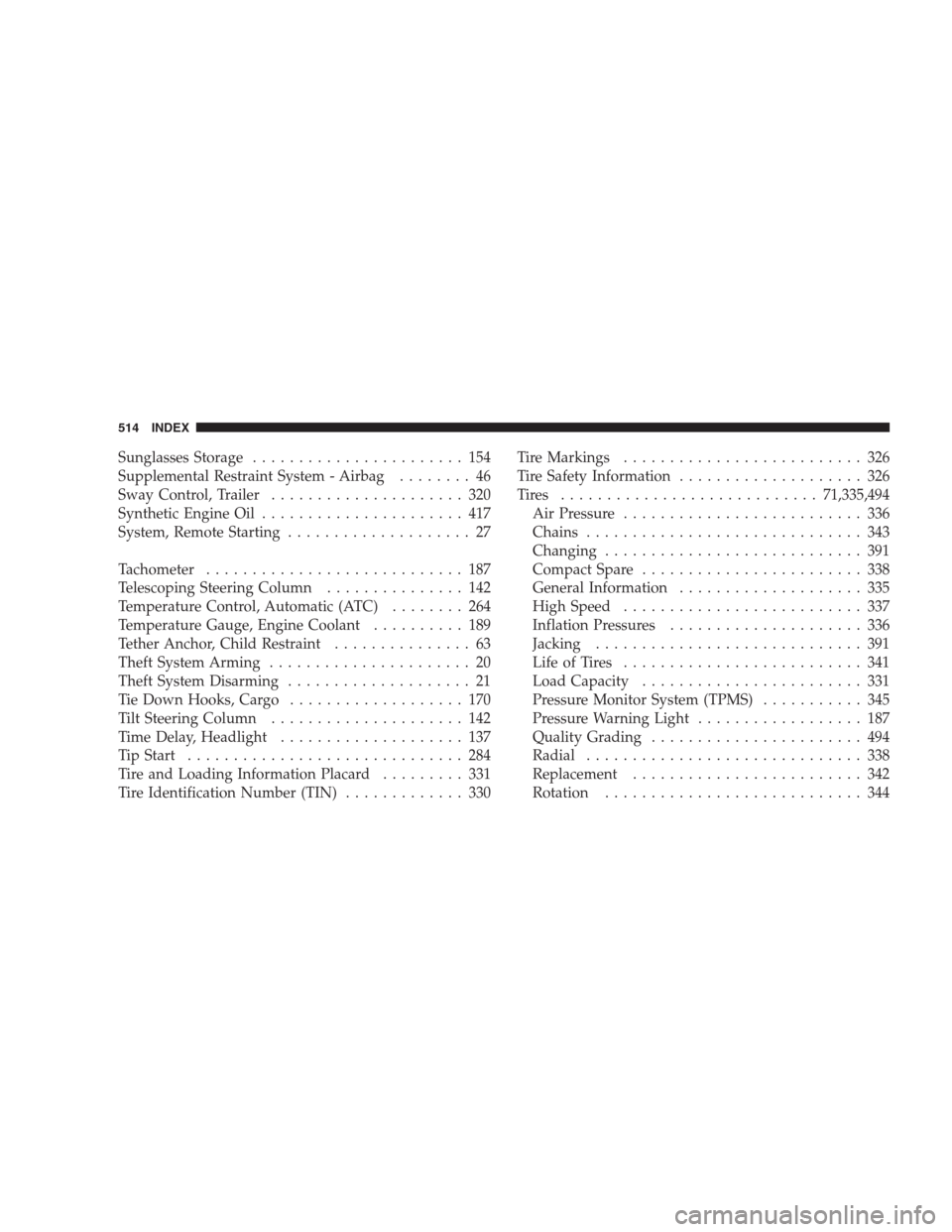
Sunglasses Storage....................... 154
Supplemental Restraint System - Airbag........ 46
Sway Control, Trailer..................... 320
Synthetic Engine Oil...................... 417
System, Remote Starting.................... 27
Tachometer............................ 187
Telescoping Steering Column............... 142
Temperature Control, Automatic (ATC)........ 264
Temperature Gauge, Engine Coolant.......... 189
Tether Anchor, Child Restraint............... 63
Theft System Arming...................... 20
Theft System Disarming.................... 21
Tie Down Hooks, Cargo................... 170
Tilt Steering Column..................... 142
Time Delay, Headlight.................... 137
Tip Start.............................. 284
Tire and Loading Information Placard......... 331
Tire Identification Number (TIN)............. 330Tire Markings.......................... 326
Tire Safety Information.................... 326
Tires ............................71,335,494
Air Pressure.......................... 336
Chains.............................. 343
Changing............................ 391
Compact Spare........................ 338
General Information.................... 335
High Speed.......................... 337
Inflation Pressures..................... 336
Jacking............................. 391
Life of Tires.......................... 341
Load Capacity........................ 331
Pressure Monitor System (TPMS)........... 345
Pressure Warning Light.................. 187
Quality Grading....................... 494
Radial.............................. 338
Replacement......................... 342
Rotation............................ 344
514 INDEX